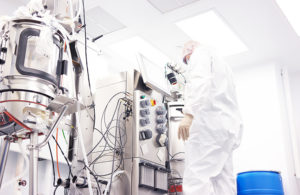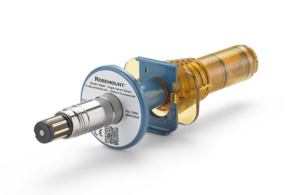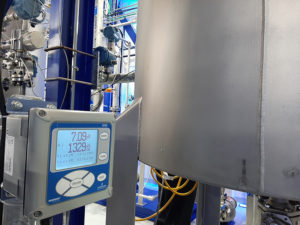
Scientist working with a bioreactor for cell culture. Pharma manufacturing requires digitalization for best results, according to experts at Emerson. [Image courtesy of Emerson]
A combination of digital tools, improved production equipment, and advanced instrumentation helped COVID-19 vaccines to roll out in record time.
Ben Arriola and Zach Blum, Emerson
There is little doubt that researchers will study the COVID-19 pandemic and its effects from countless angles in the decades to come. Few events in modern times have had such global consequences, and the changes are far from over.
The most positive element of the story has been the speed with which many research organizations and pharmaceutical companies developed vaccines to prevent COVID-19. Usually, vaccines take years to develop and test. One of the latest examples of development from scratch was the mumps vaccine in the 1960s. It took four years to complete and release, which at the time was considered extraordinarily quick.
Battling the 2019-nCoV virus has been a worldwide effort, pushing time-to-market demands for vaccine manufacturers into uncharted territory. China’s CoronaVac from Sinovac and Russia’s Gamaleya Sputnik V were first to receive widespread distribution. There are now four options between the U.S. and western Europe: Oxford University-AstraZeneca, Moderna, Pfizer-BioNTech, and Johnson & Johnson. All told, there are more than 70 vaccines in clinical trials worldwide, and nearly one-third of those have reached final stages, according to the New York Times’s coronavirus vaccine tracker.
Many have characterized this situation, with so many vaccine options developed in less than a year, as miraculous, but the reality is more nuanced. Development was possible thanks to design and manufacturing tools evolving over the last decade or two. These, combined with the ability to characterize the virus itself in extraordinary genetic detail, provided critical information. If there is a miraculous element, it is the high degree of effectiveness these combined technologies have provided beyond the expectations of many scientists at the outset.
Let’s look at two technologies that have had a critical part in the big picture – digitalization combined with improved equipment and instrumentation technologies, especially single-use technology. Both help make vaccine development faster, easier, and more cost-effective.
Digitalization
Given the complexity of pharmaceutical development and manufacturing and the need for data storage and access, it is difficult to imagine a vaccine program moving at the speeds required without digitalization on all fronts.
Vaccine development easily creates billions of rows of data, and this data must be contextualized and analyzed, with the most valuable data preserved and leveraged across the product lifecycle. Historically, data management was a manual, paper-intensive endeavor. Technology transfer, the process of transferring and scaling products from development to manufacturing, would take years. The COVID-19 vaccines have shown technology transfer can be done in months instead of years, with speed to market for new therapies accelerated through digitalization and corresponding improved data management.
Accelerating vaccine development requires unprecedented flexibility in managing data. With increasing integration between product lifecycle management systems and software—like Emerson’s DeltaV™ Distributed Control System (DCS) and Syncade Manufacturing Execution System (MES)—data, recipes, and processes can be digitally altered, shared, and used to scale across the lifecycle.
The cloud enables data to be easily accessed by global teams collaborating on projects, making it easier to manage validation. As teams scale processes up and down to meet demand or bring a new product to market, every stakeholder has visibility to the critical data necessary to do their job and properly manage compliance to speed treatment approvals. Enhanced integration and cloud collaboration eliminate many of the bottlenecks that delay technology transfer and inhibit speed to market.
The need for flexibility extends to the relationship between operators and the processing equipment used to optimize manufacturing production. Real-time scheduling software can work with process control systems like Emerson’s DeltaV automation system to leverage process control data. Benefits include predicting and optimizing resource availability and increasing total production volumes, which is particularly important for getting vaccines to patients sooner. Leveraging the data to improve production requires modular automation software and instrumentation that can easily adapt to minimize production delays or disruptions.
Single-use technology

Single-use reactor bags fit into holders matching their capacity. Ports allow mounting of process sensors as needed. [Image courtesy of Emerson]
The second tool working with digitalization is single-use technology (SUT), which has accelerated the pace of manufacturing beyond traditional stainless steel technology (SST). SUT avoids constraints posed by older processing equipment with its complex setup and change mechanisms.
With SUT, it’s possible to insert a pre-sterilized bag of appropriate size into a matching support fixture with ports for different instrumentation types. Processing takes place in the bag, and when finished, the bag is recycled or incinerated. No cleaning or sterilizing cycles are necessary.
Old fixed-in-place production units cannot deliver the kind of process flexibility required during these developments due to cumbersome configurations requiring time-consuming reconfiguration for experimental batches. Moreover, operating costs are high due to cleaning cycles using energy-intensive clean-in-place (CIP) and sterilize-in-place (SIP) systems. While this type of equipment is appropriate for the routine running of mature product campaigns, it represents a significant drag on development when time is of the essence.
Simultaneously, some manufacturers wanted to try single-use system (SUS) designs, but the lack of suitable instrumentation constrained them. Disposable bioreactor bags were available, and these were very attractive since they provided great versatility and flexibility. However, instrumentation was designed to work with SST installations.
Fortunately, instrumentation manufacturers recognized this customer need and have designed new sensors and instruments specifically for SUS applications. These have been available for a few years, and the list of options continues to grow. Many of these options have been available to support the great vaccine development race of 2020.
Matching instrument to application

Emerson’s Rosemount 550pH single-Use sensor can be preinstalled in a reactor bag. It has a two-year shelf life and can operate for 30 days without any maintenance or recalibration. [Image courtesy of Emerson]
For example, to illustrate how these elements work together, consider a process variable that must be measured and controlled universally in pharmaceutical processes: pH. Traditional pH sensors use glass-bulk technology where the sensor element is in direct contact with the process media. When used in SST systems, pH sensors must be removed or at least protected during CIP and SIP cycles, which complicates the procedure.
When working with SUS configurations, a pH sensor designed for this purpose can now be preinstalled in the reactor bag. With today’s sensors, all materials of construction can withstand the gamma radiation used to sterilize the complete bag assembly. In some cases, the sensor is inserted in the bag when manufactured, or it’s possible to insert it during bag deployment. The buffer solution in the sensor is USP 788 compliant to remain stable after irradiation and to allow use in the process after a single-point calibration. The result avoids the need for checking the calibration against a sample in the lab.
The sensor mounts in a port built into the bag so it can contact the process medium. The port must be absolutely leak-proof to ensure the aseptic integrity of the bag and process. The sensor has electrical contacts connected to a cable running to a transmitter, which takes the sensor’s analog signal and converts it to standard pH engineering units. The electrical contacts are the same for conventional pH sensors and SUS versions, so it’s possible to use the same transmitter for either application.

Emerson’s Rosemount 1056 Intelligent Four-Wire Transmitter is a multi-parameter instrument offering a range of measurement choices. Its modular design allows the replacement of signal input boards in the field for configuration changes. [Image courtesy of Emerson]
The transmitter is what makes a sensor into a useful process instrument and analyzer. As just mentioned, it converts the analog signal into engineering units. Still, beyond that, it provides the means to integrate the reading into the larger DCS and MES environment using HART or digital fieldbus communication.
It is the link to larger digitization efforts by aiding operators directly, providing process variables to the PCS, and supplying data for batch reporting and analysis. Automated data transfer from instrumentation and the PCS supports batch reporting, traceability, and data analysis.
Today’s versatile transmitters can interface with multiple sensors or multiple kinds of sensors, including pH, ORP, and conductivity. With internal diagnostic functions, it can detect a problem developing and warn operators before a batch is lost.
The key to rapid development is the use of these modern technologies combined with digital tools. It’s made today’s vaccine developments possible, and it should show pharmaceutical manufacturers what is possible going forward.
The continuing mission
The campaign against COVID-19 is just one battle in the ever-growing effort towards improved healthcare. The call for improved vaccines will not stop as long as new mutations develop and cause additional sickness and death.
Pharmaceutical manufacturers must prepare to solve the next challenge even more quickly while still controlling costs. The tools discussed here—digitalization combined with improved equipment and instrumentation technologies—will play a growing role because they make such developments faster, easier, and more cost-effective. These tools deliver operational benefits by overcoming challenges such as:
- Avoiding constraints posed by older processing equipment with complex setup and change mechanisms.
- The need for more precise control possible with sophisticated instrumentation designed for new processing equipment means fewer lost batches.
- The need to support batch reporting and traceability, which is possible with automated data transfer and analysis from instrumentation and the DCS.
These are the advances that will make the next vaccine development — and even day-to-day pharmaceutical production — more efficient, effective, and profitable.
Ben Arriola is Emerson’s global business development leader for life sciences instrumentation. In this role, his near-term focus is to help Emerson launch a new generation of analytical and measurement single-use instruments. Ben works closely with the automation software and control device business units of Emerson to help the industry realize the vision of inline monitoring and real-time release of biopharmaceutical therapies. He is an active member of ISPE and BioPhorum, and he holds an engineering and a business degree from the University of Minnesota.
Zach Blum is a global product manager for liquid analysis instrumentation at Emerson. In this role, he is focused on guiding the development and commercialization of new liquid analysis sensors and transmitters for a range of market segments, including biopharmaceutical manufacturing. Zach holds chemistry and chemical engineering degrees from the University of Minnesota, and an MBA from the University of Michigan.